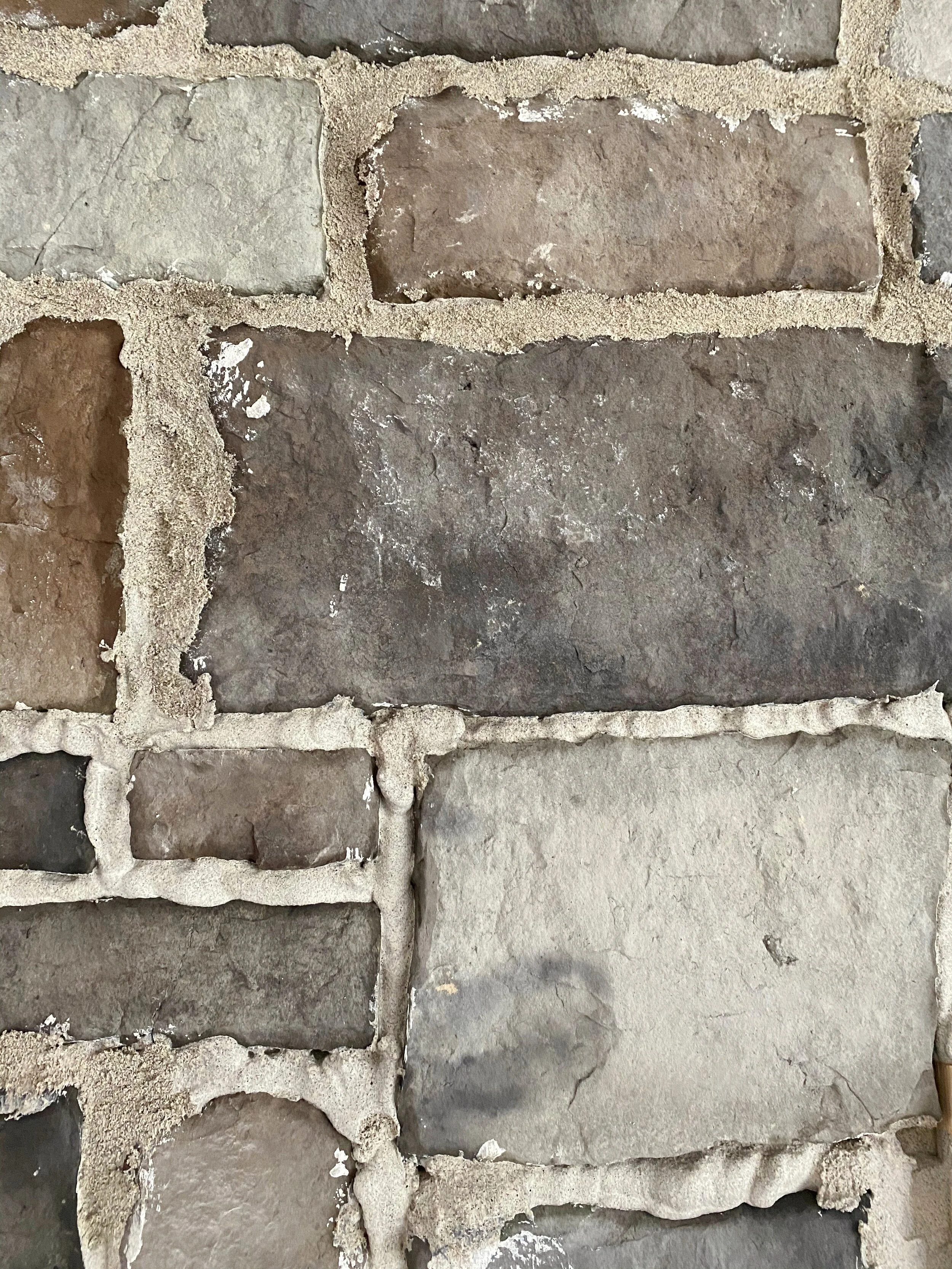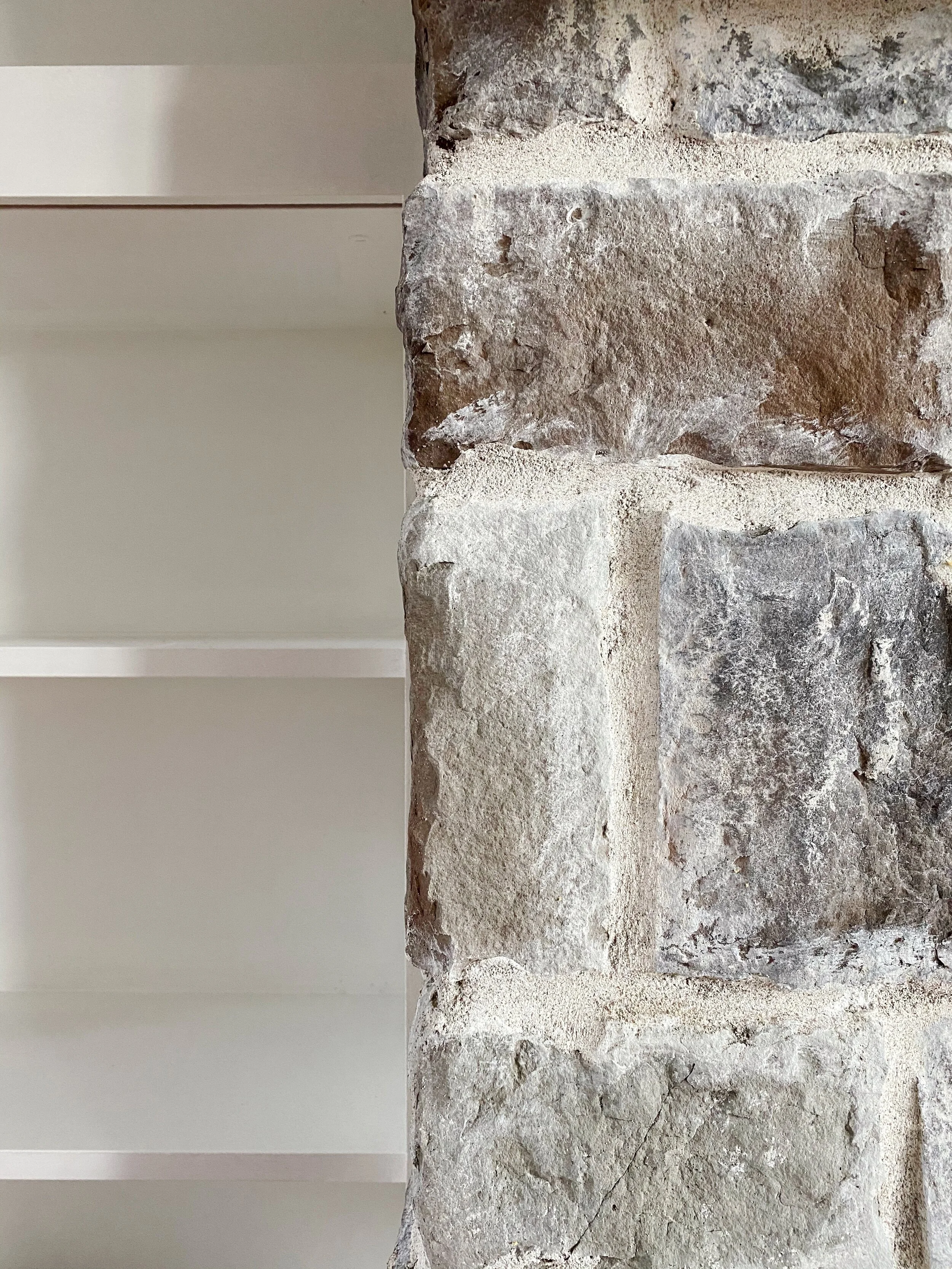How-To: Overgrouting a Stone Fireplace
With our fireplace project completely wrapped up, I thought it may be helpful to create a tutorial about how we did the grouting step. We built our fireplace from scratch and left gaps between the stone veneer when we installed it to be able to add grout, but I have seen other bloggers and YouTubers share this technique on existing stone fireplaces that either already have grout or are comprised of stacked stone. This technique is actually quite an easy and inexpensive way to spruce up some old stone, but it is fairly time intensive and physical. If you’re up for the challenge, I’d love to share the process with you so you can confidently go for it yourself. The impact is huge and definitely well worth the effort!
I’ll first warn that despite your best intentions and confidence in yourself, this is definitely a two-person job. With both Curtis and I, it took us nearly an entire Saturday to do this on our fireplace of approximately 50 square feet. You also need to be on your toes to work fairly quickly, so definitely find yourself a couple pairs of hands to speed up the process. Other than that, you’ll only need a few other supplies. But first, the inspiration that gave a direction to this whole process:
You will need:
Mortar Mix (we used King 2-1-9 in Cream) - You’ll need to research to determine how many bags you will need for your surface area. For reference, we used 1.5 bags on our fireplace, which required us completely filling the gaps, not just adding to existing grout.
Buckets (at least two)
Corded Drill with a Mixing (Eggbeater) Attachment (see if you can borrow one from someone!) - You’ll want a corded drill because it takes a lot of power to mix the mortar.
Trowel (or old spoon or scoop)
Plastic Putty Knives (1-2)
Masonry Brush (optional, but we used one)
Plastic, tarp, tape, rags, etc. - You’ll need anything you can get your hands on to protect your space. This gets messy!
Step One: Prep
This seems self-explanatory, but I will admit that it almost came as an afterthought to us. We were about to dive in to the project and suddenly thought it may not hurt to cover the built-ins beside the fireplace and a bit of the floor surface area. We ended up taking about 30 minutes to an hour to fully cover the surrounding space. We had some leftover plastic vapour barrier from another project that we taped over the built-ins and along the floor around the fireplace. We removed the shades and bulbs from the nearby wall sconces and covered them with plastic. We also ended up laying an old tarp down around the floor. It’s a good thing we did, because this process gets really messy. Cover as much area as you can with whatever you can and do your best to remove anything in the room that could be in the line of fire, such as chairs, coffee tables, sofas, and rugs. Also, find a few old rags for wiping down the walls just in case some mortar makes its way on there.
Step Two: Mix the Mortar
This is probably the trickiest part of the process because it takes trial and error to figure out the correct workable consistency of the mortar. The mortar you use may come with some instruction about ratios between the mix and water, so you could start with that and then add more water or dry mix to achieve the right balance. Essentially, you need to find a consistency that is runny enough to flow through a mortar grout bag, but that isn’t so runny that it pours down your stones.
I recommend starting by putting some water into an empty bucket and adding the mix, one bit at a time, as you blend it together (another case for having two sets of hands on the job!). Be sure to do this somewhere that can stand a bit of mess, like in a garage or outdoors. Using a corded drill with the eggbeater attachment on it, combine the water and mix until it forms really soft peaks in the mix and is well combined. Allow the mixture to sit and rest for a few minutes before continuing to mix it again - adding more water or dry mix to achieve the right consistency.
As I mentioned, the mortar mixing process is more of an art than a science and it takes some trial and error. When I did my own research, many people mentioned a “peanut butter consistency”, but we found that was too stiff to pipe. We filled our grout bag with mortar that seemed perfectly workable, only to realize we couldn’t squeeze it through. It felt frustrating to constantly empty the bag, add more water to the mixture, refill, and try again, but if you stick it out, you will eventually find the right consistency and then be able to continually reproduce that consistency throughout the process. Try to only work in small batches (about half a bag of mortar at a time) so your mortar doesn’t dry out between use. If it does start to thicken, just mix in some more water.
Step Three: Pipe the Cracks
With your foot pinching the tip of the grout bag closed against the floor, fill the bag 2/3 of the way full with mortar and twist the top opening tightly closed. This will feel awkward at first, but ensure you are holding the twisted open end closed with one hand and use your other hand to hold the weight of the bag up to guide the tip into the grout cracks. Use some pressure to squeeze the grout out and allow it to overflow out of the crack on top of the stones. Always start in the furthest point away from you and pull the bag closer towards you as you fill the gap, as pushing away from you will cause the tip to scrape through the mortar you just freshly added. When filling vertical cracks, start from the bottom and work your way up rather than from the top of the crack down.
This process is awkward until you get a feel for it. Once you do, you will be able to work pretty quickly. Some of our gaps were really big and required us to let some mortar sit in the crack for a while before adding more, like it needed something to grab onto. We tried to work pretty systematically, from top to bottom, taking note of which areas we did first. If you are simply overgrouting an existing fireplace that already has mortar, you won’t need as much of the mortar to fill in with. In that case, be careful to only let it just slightly overpour the stone surface. Try not to let it drip down the entire fronts of the stones.
Step Four: Scrape it Down
If you were doing a traditional clean mortar look, this is the part of the process that you would use a jointing tool to smooth out the grout lines with a neat little indent, much like you see in brickwork. With the overgrouted look, we instead want to scrape some of the mortar across the stones to make it flush with the stone fronts. Once the piped mortar sets for a little while (30-60 minutes), come back in with a plastic putty knife and scrape at it to cover the edges of the surrounding stones. Doing this will make the mortar appear more sandy (which you can see in the image below).
The scraping part is when this process gets extra messy! By this point in the process, I started scraping while Curt continued piping the areas that didn’t have mortar yet. It’s important not to miss your opportunity to scrape, as the mortar will begin to harden. We found it was ideal to scrape about 45 minutes after we piped it, but it could vary depending on your climate. A good way to test is that if you poke the piped mortar, there should be very little transfer on your finger. If you poked the freshly piped mortar, it would cover your finger, but when it is ready to scrape, it will appear more like a wet sand on your fingertip.
When scraping, I tried to work with the natural shapes of our stones. Our stone veneer pieces varied in depths of 1.5”-2”. In areas of the stone that were shallower, I tried to cover more with the mortar. In parts of the stone that were deeper, I let them protrude with no cover. As you work with it, you will quickly realize what feels most natural.
Step Five: Smooth It Out and Wash It Out
I really wanted a “washed out” look to my stones, essentially aiming to give every stone a light coat of white mortar wash over the surface. But whether you want this or not, you will still need to smooth out the surrounding scraped mortar joints. Using a bucket of lukewarm water and a heavy duty sponge (with most of the water wrung out), wipe across the scraped mortar joints a few times to smooth out the rough sandy texture. Doing this will scrape some of the watered down mortar onto your stone fronts so to ensure you don’t have any wipe marks, use the sponge to feather in from the edges across the stones to give them a more natural look. If you don’t want any mortar wash on the stone fronts, be very intentional about cleaning out your sponge and wiping off the stone surfaces as much as possible. At this point, it’s really hard to see the mortar wash on the stones until it dries, in which case it will be too late to remove. I tried to go really light, knowing that I could always add more later but wouldn’t be able to take any away.
We also used the masonry brush to brush across the mortar joints. This helped to really smooth them out and doing the same technique as the sponge - feathering in from the stone edges across the stone fronts - helped achieve a more natural look. Try to work at this step as soon after scraping as you can to ensure you can work with the mortar before it dries out too much.
By this point, we had finished a long days work and what stood before me was really underwhelming. I went with a cream mortar, but while it was still wet, it was impossible to see if what we did was exactly what I had envisioned for this project. As I mentioned, I opted to go lighter on the overgrouting and washing out the stones because I knew I could always come back another day and add more to it, but wouldn’t be able to remove anything I did now. By this point, we really just had to be patient and let it dry.
The cleanup process was messy, but much better with all the precautions we took to protect the surrounding area. As you can see, there was sandy mortar everywhere. We did our best to sweep it up, followed by a shop vac, and then a regular vacuum when there was just some dust remaining.
I’m going to be pretty candid here and tell you that when all was said and done, I felt disappointed. The mortar took a few days to dry and I didn’t immediately see the potential with all the hard work we had put in. I had a lot of doubt about what we achieved and actually felt pretty determined that we would need to go back in and add more mortar. However, as the mortar continued to lighten and lighten, it really started to look like my original vision. Eventually I went ahead and painted the mantle and the big picture really started to fall into place.
All this to say: trust the process. It is a laborious, exhausting, and - at points - overwhelming one, but if you are patient, it will work out and be worth all the time and effort. Every day as I sit in this room, I study the stones and feel so content and happy with the way they are so nicely nestled in the mortar. It truly is exactly how I pictured it and brings so much warmth and texture to our space.
I am fully confident that if we could do it, you can do it. I am always happy to answer any questions you may have and am more than willing to cheer you along in your process. If you have a direct question, feel free to reach out through our contact or find me over on Instagram. If you’d like to see the whole process for this build, be sure to check out our video on our YouTube channel or read about the full reveal in this post.


















